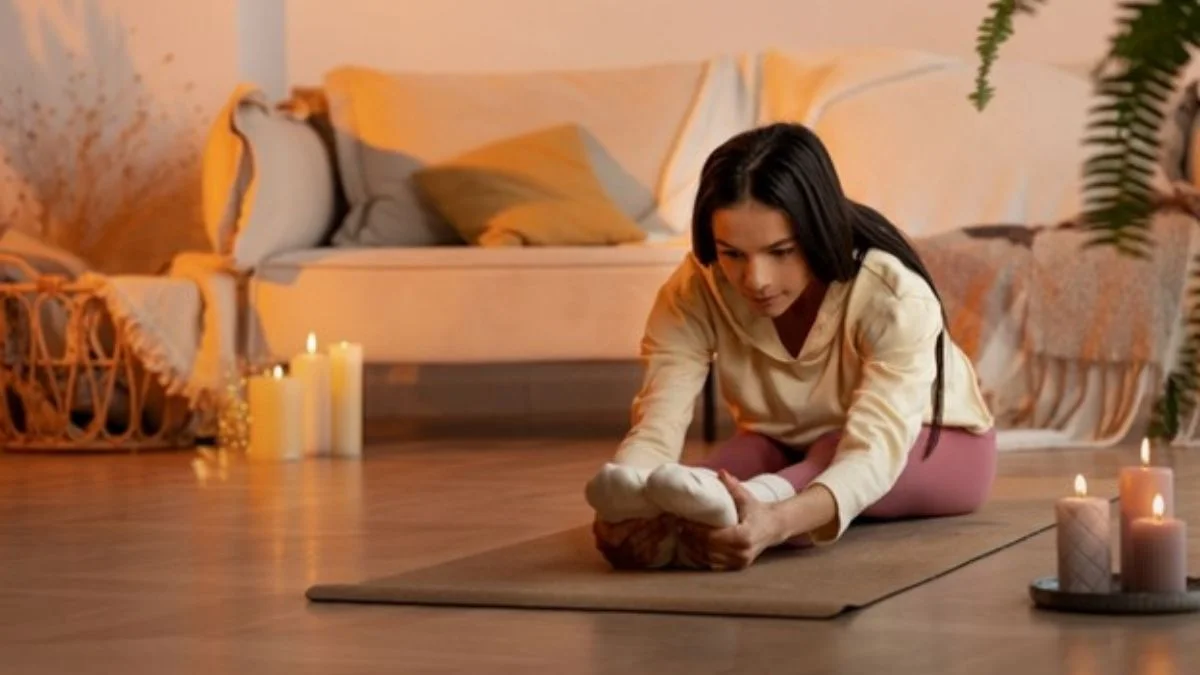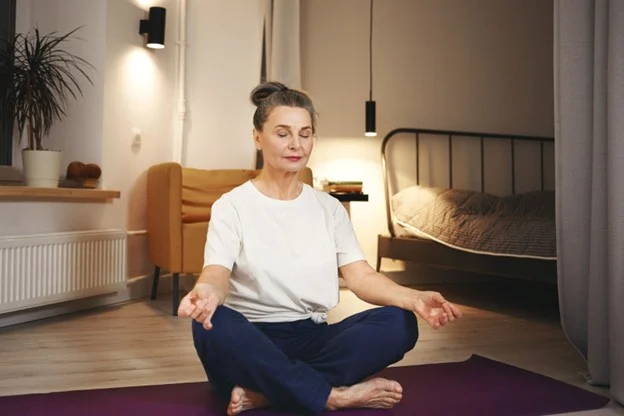GENERAL
Sleep Better by Stretching and Soothing Back Pain with Yoga and Home Tips

Nearly 65 million adults in America report a recent episode of back pain. A staggering one-third of them also struggle to fall or stay asleep because of it. It’s an exhausting, vicious cycle where pain disrupts sleep, and poor sleep amplifies pain perception.
If you find yourself caught in that loop, tossing and turning while your back throbs, know that tonight can be different. The gentle bedtime yoga sequence and simple bedroom adjustments detailed below are designed to do more than just temporarily mask discomfort.
They work together to loosen stiff muscles, calm an over-alert nervous system, and create the ideal conditions for your body to achieve deeper, more restorative rest. Best of all, no fancy studio, expensive equipment, or prescriptions are required.
Table of Contents
Why Back Pain Worsens Sleep (Evidence Snapshot)
The connection between back pain and sleeplessness is a physiological reality. When your body registers pain, it triggers the release of stress hormones like cortisol. Cortisol’s job is to heighten alertness, which is a useful survival mechanism during the day but a disaster when you’re trying to sleep.
This hormonal surge makes it incredibly difficult to transition into the deep, slow-wave sleep stages where true physical repair and muscle recovery happen. The constant struggle to find a painless position can also fragment your sleep into dozens of micro-arousals.
You might not remember waking up, but these disruptions prevent your brain and body from completing their essential restorative cycles.
Benefits of Bedtime Yoga for Back Pain
Integrating a short yoga practice into your evening routine is a powerful, evidence-backed strategy for managing back pain and improving sleep. The benefits are multi-layered:
- Activates the parasympathetic response: Slow, mindful movements paired with deep breathing shift your nervous system out of the “fight-or-flight” state and into the “rest-and-digest” mode. This biological switch actively lowers your heart rate and calms the mind.
- Gently lengthens key muscles: Many cases of lower back pain are worsened by chronically tight hip flexors and hamstrings. Bedtime yoga gently lengthens these muscles, reducing the pulling force they exert on the lumbar spine.
- Improves intervertebral disc nutrition: Your spinal discs receive nutrients through movement. Gentle spinal motions like twisting act like a pump, hydrating the discs and improving their resilience.
- Encourages mindfulness and reduces pain perception: Focusing on your breath and bodily sensations helps detach from the anxiety surrounding pain. This mindful awareness can lessen the perceived intensity of pain.
For most chronic, non-specific back pain, gentle yoga is a safe and effective approach. The key is to keep all movements slow, controlled, and within a pain-free range. Never push into a position that causes sharp or shooting pain.
Safety, Props & Mindset
Before you begin, set yourself up for a safe and calming practice. For this routine, you only need a small space on the floor. Prepare your environment by dimming the lights and gathering two standard bed pillows to use as props for support and comfort.

The most important tool is your breath. Before the first pose, practice diaphragmatic breathing. Place a hand on your belly, breathe in slowly through your nose for a count of four, feeling your belly expand.
Exhale slowly through pursed lips for a count of six, feeling your belly fall. This simple act signals to your nervous system that it is time to unwind.
| Warning/Important: Always consult a clinician if your back pain radiates down a leg, includes numbness or weakness, or results from a specific trauma. These can be signs of a serious issue. |
Bedtime Yoga Poses for Back-Pain Relief
Move through this sequence slowly, holding each stretch for 30 to 60 seconds, or about 5 to 8 deep breaths. The goal is gentle release, not an intense workout. Listen to your body and flow with steady, deliberate breathing.
Cat–Cow
Start on your hands and knees. As you inhale, drop your belly and lift your chest (Cow Pose). As you exhale, round your spine and tuck your chin (Cat Pose). Flow between these two positions for 8–10 cycles to gently mobilize your spine.
Child’s Pose with Side Bend
From kneeling, sit back on your heels and fold forward with arms extended. Walk both hands to the right until you feel a gentle stretch along your left side. Hold, then repeat on the left side.
Downward-Facing Dog, Gentle Version
From all fours, lift your hips into an inverted “V” shape. Keep your knees generously bent and focus on creating a long, straight line from your wrists to your tailbone. Let your head hang heavy to release neck tension.
Kneeling Hip-Flexor Stretch
In a low lunge with your right knee on the ground, gently tuck your pelvis under. You should feel a stretch in the front of your right hip. This pose releases tension that can pull on the lower back during sleep. Hold, then switch legs.
Figure-Four (Reclined Pigeon)
Lie on your back with knees bent. Cross your right ankle over your left thigh. To go deeper, gently draw the left knee toward your chest. You’ll feel this in your right glute and piriformis muscle. Hold, then switch sides.
Sphinx (or Low Cobra)
Lie on your stomach and prop yourself up on your forearms with elbows under your shoulders. Gently lift your chest, keeping your hips grounded. This is a mild backbend that strengthens muscles supporting your spine without compression.
Happy Baby
On your back, draw your knees toward your armpits, with the soles of your feet facing the ceiling. Grasp your feet or ankles and keep your lower back flat on the floor. Gently rock from side to side for a massage-like effect.
Two-Knee Spinal Twist
Hug both knees into your chest, then extend your arms to the sides in a “T” shape. Slowly lower both knees to the right side, letting them rest on the floor or a pillow. Turn your gaze to the left to gently unwind your spine. Repeat on the other side.
Wall-Assisted Groin Stretch
Sit with one hip against a wall and swing your legs up. Slowly open your legs into a wide “V” shape, allowing gravity to provide a passive stretch for your inner thighs while your lower back flattens against the floor.
Diaphragmatic Breathing in Supine
Lie flat on your back with your knees bent or straight. Place both hands on your lower belly and close your eyes. Inhale deeply through your nose, allowing your belly to rise, then exhale slowly. Ten conscious breaths here will deeply calm your nervous system.
| Pro Tip: Listen to your body. While a mild stretch is beneficial, you must immediately back off from any pose that causes sharp, stabbing, or radiating pain. Never force a movement. |
Home Comfort Strategies to Amplify Relief
Your sleep environment plays an enormous role in managing back pain. Pair your yoga routine with these strategies for a comprehensive approach to pain-free rest.

Pillow Placement Hacks
- Side sleepers: Place a firm pillow between your knees. This prevents your top leg from twisting your pelvis and lumbar spine overnight, helping maintain neutral alignment.
- Back sleepers: Slide a pillow beneath your knees. This slightly elevates your legs, which helps to flatten the curve in your lower back and release tension.
Mattress & Topper Tweaks
The surface you sleep on for hours matters immensely. Research consistently finds that medium-firm sleep surfaces outperform other options for people with chronic back pain. If your bed is old and sagging, it is not providing the support your spine needs.
As a first step, try rotating it every three months. If that doesn’t help, a supportive mattress topper can improve the surface. For a lasting solution, a high-quality mattress engineered for balanced firmness, like Koala’s, enhances support and comfort while also improving morning stiffness.
Optimal Sleep Positions
- Fetal-side position: Lie on your side with your knees slightly drawn up toward your chest, and place a pillow between them.
- Supine with support: Lie on your back with a bolster under your knees and a small, rolled towel under the curve of your neck.
- Avoid prone sleeping: Sleeping on your stomach often forces your head to one side and can cause your lower back to hyperextend, placing stress on your spine.
Does It Really Work?
The combination of gentle movement and sleep hygiene is backed by a growing body of scientific research. For instance, a systematic review of 27 studies found that yoga was associated with short-term improvements in pain intensity and physical functioning compared to passive controls. This reinforces the idea that mindful movement is a proactive tool for relief.
Furthermore, the Agency for Healthcare Research and Quality found that yoga improved pain and function in both the short-term and intermediate-term. The consensus is clear: combining targeted therapeutic movement and strategic sleep hygiene yields faster, more effective, and longer-lasting relief.
| Key Insight: Research shows a powerful link between gentle yoga and better rest. One study found participants gained an average of 55 minutes more total sleep per night after starting a routine. |
The Takeaway & Gentle Call-to-Action
Breaking the cycle of back pain and insomnia begins with small, consistent actions. By dedicating just 15 minutes each evening to this gentle movement routine, you can significantly reduce muscle tension, calm your nervous system, and set the stage for restorative sleep. Try the routine tonight and pay close attention to how you feel in the morning. Adjust the poses or use more props to suit your unique body. Your journey toward better sleep can start now.
-

 GENERAL6 months ago
GENERAL6 months agoChristofle – For Those Who Dream of Family Heirloom Silver
-

 SPORTS8 months ago
SPORTS8 months agoDiscover the World of Football with Streameast: Watch Your Favorite Leagues and Tournaments
-

 GENERAL4 months ago
GENERAL4 months agoUncovering the World of кинокрадко: The Dark Side of Film Piracy
-

 GENERAL2 months ago
GENERAL2 months agoATFBooru: Anime, Gaming, and Subculture Imageboard























